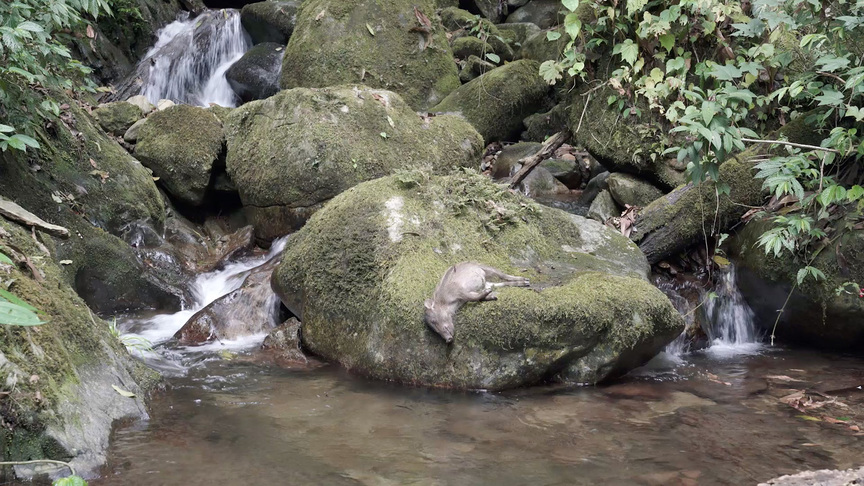-
From Current Issue
-
- Editor’s Letter Fire in the Heart
- Reviews I Gusti Ayu Kadek Murniasih
- Reviews 11th Seoul Mediacity Biennale: “One Escape at a Time”
- Dispatch Networked China
- One on One Monira Al Qadiri on Yukio Mishima
- Essays The rise of independent art spaces in pandemic-era Shanghai
- Features Tuan Andrew Nguyen
- Table of Contents
- Web Exclusives
- Archive
- Subscribe

R
E
V N
E
X
T
Installation view of CHEN XINHAO’s solo exhibition “The Fool’s Gold,” at OCAT Shenzhen, 2019. Courtesy OCAT Shenzhen.
For many in China, 56 comes instinctively as the answer to how many ethnic groups there are across the country. This entrenched idea, inseparable from the government’s scheme of realizing ethnic plurality under the premise of national unity, seemingly suggests inclusivity and diversity. Yet, in actuality, many groups have been excluded from the official list of minorities, including the Mang people, who live in Yunnan province’s borderland near Vietnam, and who struggle to define their geopolitical and ethnic identity.
Tied closely to this context, Cheng Xinhao’s solo exhibition at OCAT Shenzhen foregrounded the Mang people’s unacknowledged presence in China’s ethnographical archives. The exhibition presented 17 video works selected from Cheng’s research project Strange Terrain (2013– ), centered around this minority group. At OCAT, this story, which began in the remote area surrounding the Sino-Vietnamese border, was extended with a new chapter related to Shenzhen, based on Cheng’s recent fieldtrip, during which he followed the Mangs who had migrated to this coastal metropolis for better job opportunities.
Installation view of CHEN XINHAO’s I Will Sprinkle Salt All Over Your Land, 2017, three-channel video: 6 min 40 sec, at “The Fool’s Gold,” OCAT Shenzhen, 2019. Courtesy OCAT Shenzhen.
There were two possible trajectories along which to view the exhibition. These routes began on either side of the video installation, I Will Sprinkle Salt All Over Your Land (2017). A mountainous landscape stretches across three screens, with the central channel focused on the border, while the videos on the sides respectively capture Vietnamese and Chinese territories, indicating the two geographical starting points of the viewing routes. Behind this work, in the room’s dim cavity, video pieces were strewn across a central installation of rolling steps, which were designed to reference the contours of the mountains that border the Mangs’ homeland. Depending on which entrance viewers chose, they experienced the minority’s migration from their villages to the city chronologically or in reverse order, via the moving images.
I chose the route on the left, which began in the remote forests of the Mangs’ homeland. Two nearly still videos, A Boar (2018) and The Invasion (2017), with imageries of wildlife and jungle hunts, served to contextualize the story in the nearby video I Want to Make a Film (2018). While making a documentary about “Mang people’s original life” in the forests, Cheng asks his friend Z to play the role of himself—an authentic Mang. Z ponders, pauses and moves carefully. His gestures reveal how he ruminates over his identity and attempts to perform a role accordingly. Walking further inside, another performative work, There They Return Again (2019), features Cheng’s own body. Three successive screens showed the artist sending a log that has been washed downstream back to the waterfall where it originally grew. Using physical labor as his medium, Cheng metaphorically conveys an individual’s longing for a collective identity amid migration. Around a corner, Assembly Line 1 and 2 (2018) focus on a Shenzhen factory—the work place of Mang people who have migrated to the city. Another video installation, A Gaze (2018), takes Shenzhen’s night streets as its focus. A dim projection is cast on two luminous TV screens, which each feature a migrant worker in the foreground. These figures stare directly into the camera, while the eyes of passers-by also occasionally glimpse into the lens, reflecting the light and shining frightfully. This contrast between light and dark symbolically evoked the tension between the known and the unknowable, making the concrete, urban forest a seemingly more hostile place than the perilous jungle.
Outside the gallery was the exhibition’s eponymous display, Fool’s Gold (2018)—the first and last work that visitors encountered. The title of the video installation refers to the alias for pyrite, often mistaken for gold. Looped on a trio of screens, the footage features a disembodied hand stacking pyrite cubes into a tower before the pile collapses due to gravity. The futile, laborious accumulation is a metaphor for the repetition and practice through which we construct our identity, while the pyrite alludes to the socio-political forces that shape how we assign values to objects, thus underscoring the artifice of our value systems.
Identifying as an anthropologist, Cheng’s videography reminds me of the filmmaking style of Cinéma Verité, which regards documentary-making as an active dialogue between the director and their subjects. Cheng manages to capture reality by participating in it, and by doing so—as the French filmmaker and anthropologist Jean Rouch wrote in his book Ciné‐Ethnography (2003)—“that which is hidden or repressed comes to the surface."
Cassie Liu is an editorial intern of ArtAsiaPacific.
Cheng Xinhao’s “The Fool’s Gold” is on view at OCAT Shenzhen until August 18, 2019.
To read more of ArtAsiaPacific’s articles, visit our Digital Library.


















